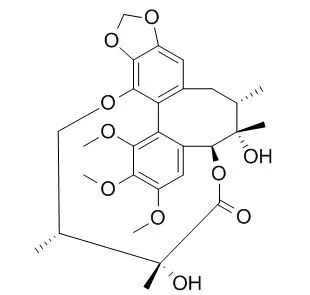| Kinase Assay: |
| Phytother Res. 2015 Oct;29(10):1658-64. | | Inhibition of UDP-Glucuronosyltransferases (UGTs) Activity by constituents of Schisandra chinensis.[Pubmed: 26084208] | Structure-activity relationship for the inhibition of Schisandra chinensis's ingredients toward (Uridine-Diphosphate) UDP-glucuronosyltransferases (UGTs) activity was performed in the present study.
METHODS AND RESULTS:
In vitro incubation system was employed to screen the inhibition capability of S. chinensis's ingredients, and in silico molecular docking method was carried out to explain possible mechanisms. At 100 μM of compounds, the activity of UGTs was inhibited by less than 90% by schisandrol A, schisandrol B, schisandrin, schisandrin C, schisantherin A, Gomisin D, and gomisin G. Schisandrin A exerted strong inhibition toward UGT1A1 and UGT1A3, with the residual activity to be 7.9% and 0% of control activity. Schisanhenol exhibited strong inhibition toward UGT2B7, with the residual activity to be 7.9% of control activity. Gomisin J of 100 μM inhibited 91.8% and 93.1% of activity of UGT1A1 and UGT1A9, respectively. Molecular docking prediction indicated different hydrogen bonds interaction resulted in the different inhibition potential induced by subtle structure alteration among schisandrin A, schisandrin, and schisandrin C toward UGT1A1 and UGT1A3: schisandrin A > schisandrin > schisandrin C. The detailed inhibition kinetic evaluation showed the strong inhibition of gomisin J toward UGT1A9 with the inhibition kinetic parameter (Ki ) to be 0.7 μM. Based on the concentrations of gomisin J in the plasma of the rats given with S. chinensis, high herb-drug interaction existed between S. chinensis and drugs mainly undergoing UGT1A9-mediated metabolism.
CONCLUSIONS:
In conclusion, in silico-in vitro method was used to give the inhibition information and possible inhibition mechanism for S. chinensis's components toward UGTs, which guide the clinical application of S. chinensis. |
|
| Structure Identification: |
| Zhongguo Zhong Yao Za Zhi. 2014 Aug;39(15):2900-6. | | Influlance of different drying methods on quality of Schisandrae Chinensis Fructus[Pubmed: 25423829] | To study the influence of different drying methods on the quality of Schisandrae Chinensis Fructus and thus provide useful reference for its proper drying methods.
METHODS AND RESULTS:
Schisandrae Chinensis Fructus was processed by eight drying methods including vacuum freeze drying, natural drying in the shade, drying in the sun, oven drying and vacuum drying under different temperature. The contents of the functional ingredients includes chisandrin, Gomisin D, gomisin J, schisandrol B, angeloylgomisin H, angeloylgomisin Q, gomisin G, schisantherin A, deoxyschisandrin, schisandrin B, schisandrin C, 5-HMF, total aids and total sugars. The main components change after drying were analyzed by HPLC, ultraviolet spectrophotometry and potentiometric titration. Principal component analysis (PCA) was carried out by SPSS software to evaluate the quality of different processed products from Schisandrae Chinensis Fructus.
All these results are in accordance with the requirements of Chinese Pharmacopoeia published in 2010, the contents of schisandrin and total eleven lignans were the highest using vacuum drying, and 5-HMF were the lower, oven drying made little difference but with lower schisandrin and higher 5-HMF as the heat increased.
CONCLUSIONS:
Different drying methods have significant influence on the quality of Schisandrae Chinensis Fructus. Oven drying under 5°C should be adopted to substitute drying in the sun according to the China Pharmacopoeia published in 2010 for Schisandrae Chinensis Fructus by comprehensive analysis of the cost, content and practicality. |
|






 Cell. 2018 Jan 11;172(1-2):249-261.e12. doi: 10.1016/j.cell.2017.12.019.IF=36.216(2019)
Cell. 2018 Jan 11;172(1-2):249-261.e12. doi: 10.1016/j.cell.2017.12.019.IF=36.216(2019) Cell Metab. 2020 Mar 3;31(3):534-548.e5. doi: 10.1016/j.cmet.2020.01.002.IF=22.415(2019)
Cell Metab. 2020 Mar 3;31(3):534-548.e5. doi: 10.1016/j.cmet.2020.01.002.IF=22.415(2019) Mol Cell. 2017 Nov 16;68(4):673-685.e6. doi: 10.1016/j.molcel.2017.10.022.IF=14.548(2019)
Mol Cell. 2017 Nov 16;68(4):673-685.e6. doi: 10.1016/j.molcel.2017.10.022.IF=14.548(2019)